CHAS
Wild Frontier Ecology are now accredited contractors on the Contractor Health & Safety Assessment Scheme (CHAS). This should enable us to work on many different development sites.
Wild Frontier Ecology are now accredited contractors on the Contractor Health & Safety Assessment Scheme (CHAS). This should enable us to work on many different development sites.
I’ve been a seasonal assistant ecologist at Wild Frontier Ecology for 9 months and I’d like to think that I’ve come a long way and learnt a lot. From my first day when I arrived fresh faced and excited, through the newt season (when we all became decidedly less fresh faced but no less excited), past fields of phase 1s to finally ending up sat at a desk wearing a bobble hat and inputting bird data it’s been a wonderful adventure of ups, downs and occasional horizontals (most notably when I slipped on a sugar beet and ended up lying on my side looking up at a rather amused colleague).
I started in April, the lone seasonal (for a whole week), and was soon up to my armpits (literally) in bright pink disinfectant. I loved the great crested newt season, even with the late nights. It’s incredibly exciting pointing a torch bigger than your own head at a pond and not only spotting a GCN but suddenly realising you’ve managed to learn to tell whether it’s a male or female. However, the down is just around the corner and comes in the form of over 200 used bottle traps that need be disinfected before they can go near another pond… and that’s what seasonal assistants are for. By the end of the newt season not only was I good at newt surveys I had become incredibly efficient at bottle washing, cane wiping and boot cleaning. At least we had playing tennis at lunchtime on the courts outside the office and laughing at each other falling in ponds to keep us sane.
After newts came the reptiles and phase 1 surveys, hours of walking around fields looking at your own feet, because let’s face it, most of the plants are on the floor and you don’t find many grass snakes up trees. It’s a steep learning curve of plant names, tree species, habitat types and reptile spotting but it beats the gym for getting you in to shape and you get a lovely tan (even if it is just on the back of your neck and that awkward spot where your t-shirt rides up). The rest of the team all know their stuff and are so willing to share their knowledge that by the end of the surveys I’d learnt to handle adders, catch slow worms (they’re only slow in name, believe me) and name most common trees (somehow I didn’t learn this skill on my marine biology degree).
By July we were well and truly into the bat surveys, which is different again (not least because you get to look up for a change) and presents a whole new set of adventures. Such as walking around fields in the dark, strapped to a bat detector and wishing you’d worn wellies. Or finding yourself sat in a ditch under a hedge hoping the herd of bullocks will get bored of you. A week later (and after some encouraging words from colleagues) I bravely walked back across the same field, gave the bullocks a stern talking to (along the lines of “I’m not scared of you, so there!”) and conquered my fear of cows! I also learnt to analyse bat data and recognise a variety of calls.
With October came rain and we had to change from outdoor tennis to ping-pong in the meeting room and I found myself sat over a microscope identifying aquatic invertebrates, a job which I thoroughly enjoyed as I have a particular interest in this group and love any excuse to learn more about them. Although, by the end of the samples I did see aquatic inverts every time I closed my eyes, but that may have just been the fumes from the preservative.
November arrived, the other seasonal assistants were long gone and the weather turned cold. I knitted a new hat and we all began the slow descent into the winter ecologist. All the data input and analysis, report writing, equipment cleaning and ping-pong playing that got neglected during the hectic field season needed doing. It was very different to the field work but analysing the data collected through the year and writing the reports was interesting in its own way and led to a deeper understanding of what we’d all achieved through the year by standing in fields and falling in ponds.
But now December is here and with it the end of my contract, with only the Christmas party to look forward to before I leave. So, how would I sum up the last 9 months? I think the best way would be to say that it’s a rollercoaster of late nights, cute critters, wet feet and tired eyes… but bring on March because I can’t wait to do it all again!
– Claire
The works to repair and enhance the flood defences at Burnham Overy, and to repair the footpath through to Burnham Overy Staithe, were successfully completed in July 2011. The works were subject to delays as a result of the presence of natterjack toads and common lizards. A total of 338 lizards, 10 natterjack toads, 129 common toads, 10 common frogs and 6 smooth newts were translocated during the course of the project.
The natterjack toads and common lizard were moved into the dunes while the other amphibians were all released approximately 1km south of the start of the works area in the grazing marsh.
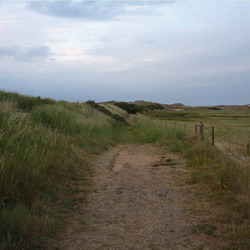
View prior to work
The works at Burnham Overy were initially due to start in 2009, but were delayed as a result of a desk study that revealed the presence of natterjack toads on the site. It was too late in the 2009 season to survey for natterjack toads, and Natural England had also advised restrictions on the acceptable timing of the works in order to avoid disturbance to the wintering birds on the grazing marshes. The project was necessarily delayed until the 2010, when it was anticipated that surveys would establish the level of presence by natterjack toads and mitigation to translocate reptiles and natterjack toads would commence.
In readiness for the start of works in 2010, reptile translocation from the bank was started (221 lizards were caught and translocated to the dunes) and a vegetation survey was conducted. The vegetation of the banks was cut short to reduce the habitat value for lizards and displace the majority of the population. The shrubby sea-blite and other potential refugia were removed from the bank and used to create an artificial reptile hibernacula at the back of the dunes.
The works to the bank were delayed, and did not start in 2010 Fortunately an agreement with Natural England was reached to remove the bird-related timing restrictions placed on the works so that these could be started in the spring of 2011. As the site is regularly disturbed by large numbers of walkers, dogs and cyclists, it was agreed that the increase in activity due to the works was unlikely to have a significant additional detrimental effect on nearby breeding birds.
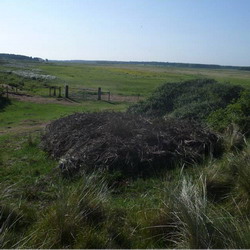
Creating a reptile hibernacula
Dry weather reduces the activity of natterjack toads significantly, and owing to the extraordinarily dry spring in 2011, the natterjack toad surveys and mitigation was again delayed. However, work continued to translocate lizards and to maintain the vegetation cutting to deter them from the bank. A further 72 common lizards were translocated in 2011 prior to the works.
Once the weather was suitable, torchlight searches for natterjacks began, and animals located on or near the bank were removed to suitable foraging habitat in the dunes.
61 natterjack toads were seen during the searches, which covered the bank and dunes. Of these 9 were on or near the bank and needed to be translocated.
The plan was to divide the bank into four sections. As each section was cleared of natterjacks and lizards, it could be signed off and the topsoil stripping could begin.
Works started in April 2011 on the end of the bank farthest from the dunes. The top soil stripping was overseen at all times by a minimum of two ecologists. 45 lizards were caught and translocated during the top soil stripping of the bank. 1 natterjack toad was unearthed in the last 50m of bank, right at the base of the bank in a patch of sand that was checked before being tracked over.
As the works coincided with the breeding bird season a survey was completed by a qualified ornithologist along the haulage and works corridor. The survey covered the works corridor plus a 50m buffer either side. There were strong indicators that birds were holding territories along the haulage route and in the salt and grazing marshes adjacent to the works corridor.
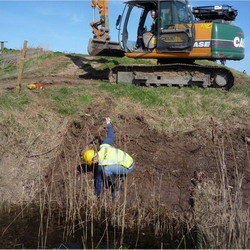
Seth checks for water vole
Bearded tit juveniles were seen in the reeds next to the haulage route confirming successful nesting during the works, and lapwing alarm calls from the grazing marsh indicated that they likely had chicks. Redshank, meadow pipit and little grebe were also heard calling from the marshes indicating that they were likely to be holding territories. Sedge warbler, blackbird, goldfinch, skylark, wren and reed warbler were heard singing this is also a sign that they were holding territories. Oystercatchers, spoonbill, black-tail godwits, little egret, tufted duck and shelduck were all observed foraging within 50m of the works corridor.
Access for this and future works to the bank was improved where the haulage route crossed over a dyke separating the grazing marsh from the foot of the bank. Improvements to the dyke crossing were mitigated for potential water vole impacts by cutting short the vegetation along the dyke edges to displace any activity. The digging works commenced with an ecologist on-site to monitor the turf stripping and to check any potential water vole burrows revealed by the gradual removal of soil. No occupied water vole burrows were found during the works to prepare the dyke crossing.
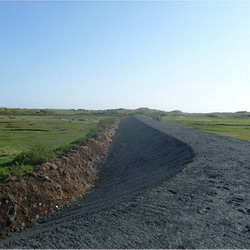
Re-profiled clay bank before dressing
The topsoil stripped from the floodbank was used to re-cover the front face of the repaired bank, while new topsoil was imported to dress the rear face. The rear face was seeded with a seed mix drawn up by the Environment Agency. The front face was not reseeded as the topsoil used to cover it originated from the bank and was presumed to have a viable seed bank. Some of the topsoil from the bank was also used to cover the artificial reptile hibernacula.
In 2012, we have been back to the site to for natterjacks use along the works corridor and the surrounding area. Adult natterjacks were found within the dunes to the north of the works corridor. In the ponds closest to the works natterjack spawn was present along with 45 adult natterjacks. Males were heard calling from the ponds and grazing marshes. Adult toads were seen at the northern end, on the rear face, of the worked bank and around the hibernaculum.
This year has been pretty full on so far, with Wild Frontier Ecology being involved in a really interesting variety of projects all over the country. We have also been busy improving our work space, making the second office into a pleasant and convivial meeting place.
Workwise, much of the early season was devoted to reptile and amphibian works, with a lot of staff time devoted to the Broadland Flood Alleviation Project, and two mitigation schemes, one in West Norfolk and the other along a popular stretch of the Norfolk Coast at Burnham Overy.
The latter was a rare chance to work with natterjack toads, a European protected species of restricted range. This slow, warty creeper of the dunes loves to burrow into soft sand, so we had to make sure that areas disturbed by essential sea wall maintenance were natterjack free. An interesting by-catch was a large number of common lizards, removed to the safety of the dunes to prevent killing and injury.
Breeding bird surveys also run in the April to June period, and we were assigned a number of wind farm proposal sites to survey. These proposals are often in intensive farmland, so the yield of interesting bird species can be quite low, although sometimes we are lucky enough to encounter a few goodies. Over the years this kind of survey has picked up stone curlew, crane, woodlark, quail and red-backed shrike, as well as good fistfuls of red and amber-listed farmland birds. This kind of survey is highly skilled, with the surveyor needing to know songs and calls of a large number of species.
This year has seen a definite upturn in the number of BREEAM and Code for Sustainable Homes assessments we have been involved with. These are often brownfield sites, and as the BREEAM credit system is based on the number of plant species present, it is usually to the developer’s benefit that the existing site is not very diverse. However, we do find that most of our clients are very keen to create a positive biodiversity benefit, even on the most urban of sites.
Our Norfolk bat surveys, as well as those in Suffolk and Cambridgeshire, have been turning up a good number and variety of bat species this year. Typically barn conversions or demolition/ rebuilds, the most frequent species are the two pipistrelle species and long-eared bat. The enigmatic barbastelle appears from time to time, although often as a single specimen. Bat surveys on wind farm sites are also rolling on, and we now have an impressive silent army of static detectors for this purpose. Transect surveys with handheld Duet bat detectors are also a regular feature of the wind farm investigations.
Finally, we have also been busy attending the small wind conference in March, giving presentations on small wind developments and ecological risk, contributing to research into Norfolk barbastelles, showing reptiles to members of the public and conducting bat walks.
Looking forward, the autumn is likely to bring a lot more bat surveys, and often a rush of small development projects as they look to get planning permission before the winter sets in. There is often another peak of reptile work in August/ September, while bird vantage point surveys continue, and reports and assessments become more of a priority.
Rob
I’ve always been fascinated by the daily movements of gulls across the part of north Norfolk that I know so well. Ever since I can remember, looking up to the skies on a winter’s afternoon, I would see numbers of gulls in straggling V formations heading northwards towards the coast. In my razor sharp teens I would set up my telescope out of my bedroom window to watch and count the considerable formations of black-headed, common, herring, greater and lesser black-backed gulls steadily moving coastwards.
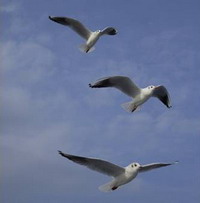
Gulls in flight
Of course, I wanted to know where these birds were heading, where they had been and what they were doing during the day. I still haven’t really got all the answers, but gradually a few observations have helped me to have some understanding of this daily commute as predictable as the sunrise and sunset.
The general pattern seems to be that of a night-time gull roost at the coast, probably Wells Harbour, but maybe other places too. Then, as I have now seen many times, a dawn or pre-dawn southward movement and dispersal. This is very noticeable at my house in Foulsham, where each morning flocks of common and black-headed gulls come in low across the fields from the north-west, often settling for a short time before moving on.
During the daytime, the gulls often display a more random movement, presumably roaming in search of good food sources. Then, early or mid-afternoon, the familiar V shaped formations start appearing with a steady northward bearing, back to the coast. There is at least one regular en-route stop-off, the lake at Holkham Park where gulls will pause for a brief wash before flying down the length of the serpentine lake towards the tidal sands of Wells.
Although the five species mentioned above are the most usual, other gulls will inevitably get caught up in these daily movements. Viewed from my stupendous back garden one early morning a few years ago in March were two perfect summer plumaged adult Mediterranean gulls, mixed in with the commons and black-heads. I am sure that keen gull-watchers would find yellow-legged, Caspian and maybe glaucous and Iceland gulls every now and then.
Some mysteries remain. Presumably in other areas, the gulls perform the same commuting movements to and from other roosts. It would be interesting to map the hinterland from each roost; how far is a gull prepared to fly for its scavenged lunch?; what observations have been made at the north Norfolk roost (numbers? What happens when it’s high tide?; And are there well-used flight lines overland, or is it just a random spread of flocks across a broad front (I think there are flight lines).
For me, a wintry Norfolk sunset is not complete without a gull or two.
Rob

Robert Yaxley
Rob Yaxley is Wild Frontier’s director and chief gull lover. His hobbies include obsessive pursuits such as counting the freckles on his children’s faces, adding up the numbers on number plates and collecting wooden rhinoceri under 10cm in length.
The Phase 1 habitat survey. To those in the industry this is a well known term; to those outside our little world this can be another piece of mysterious jargon. So here is my guide to a ‘Phase 1 habitat survey’.
A Phase 1 habitat survey is designed to map an area under consideration based on the habitats present. As ecological consultants we use it as tool to inform on the need for further survey; as a baseline to record an area’s current state; or to help in the impact assessment of a development.
In a Phase 1 habitat survey, habitats are assigned a type in accordance with guidance set down by the Joint Nature Conservation Committee (JNCC); primarily this refers to the landscape structure and vegetation present. With standardised habitat definitions and map colour schemes, areas can be compared at a national level. As well as large habitat areas, boundary features are also assessed and classified. Hedges and ditches can also be important habitats. The output from a Phase 1 habitat survey is often a colourful map, with additional “target notes” to provide further information on any points of interest and habitats too small to map.
Whilst a Phase 1 habitat survey is exceedingly useful, an extended Phase 1 habitat survey is often preferred. This provides further information on a site, above that specified by JNCC, and allows the survey results to be of use in the context required, for example the assessment of a proposed development. An extended survey might include more detailed information on hedgerows, a botanical species list, and a further appraisal of the areas as habitat for legally protected species. As the major component of any Phase 1 habitat survey is the time taken walking the site the extended survey information can generally be obtained with minimal additional effort on the part of a competent surveyor.
A Phase 1 habitat survey is generally the first survey undertaken at a site and is often akin to a site assessment. By determining what habitats are present on a site the ecologist can say what, if any, protected species might be supported there. They can then assess the need for any further targeted surveys. Common protected species surveys in lowland habitats are for badgers, bats, breeding birds, great crested newts, otter, reptiles and water vole. However, it is exceptional that all these surveys would be required on a small site. Although protected species surveys are generally the second phase of ecological assessment of a site, in the jargon a Phase 2 survey specifically would refer to further botanical work on a site. This is generally in the form of a more detailed vegetation survey called ‘National Vegetation Classification’ (NVC). For the majority of lowland development work this level of vegetation survey is not necessary.
Ideally a Phase 1 habitat survey would be the first survey undertaken, this is inevitably not always the case. A Phase 1 habitat survey is best conducted between April and October when deciduous and annual plant species are identifiable. Dependent on a site we can often undertake an initial assessment to get a project underway. For many small development sites a Phase 1 habitat survey may not be appropriate as it takes a landscape approach. However, the same skills can be applied to assess the habitat quality of a site on a small scale.
As an ecologist the Phase 1 habitat survey is one of my favourites. By its very nature the most interesting habitats on a site must be inspected, and as these surveys often take us off roads and footpaths it provides the opportunity to be inquisitive and see the flora and fauna in areas that would normally be off limits. This off-piste kind of activity does also come with its disadvantages. As the newest addition to a field the local livestock normally find you fascinating. Then of course there may not be the handy gates and styles a footpath has to offer. Deep ditches, dense hedges and barbed-wire fences all provide their own challenges and impenetrable barriers normally show up just when it’s least convenient. Finally with thousands of plant species in the UK aspects of this survey are by no means easy. Plants may stay still, but they can hugely variable in size and form depending on the surrounding conditions. Still give me an interesting site any day, I like a challenge.
A Phase 1 habitat survey can often be a considerable walk in the countryside, so let’s face it as long as it’s not pouring with rain that is always better than a day in the office!
Susie

Susannah Dickinson
Susie has always liked plants (although maybe not grasses). She cut her teeth as a Phase 1 habitat surveyor working on surveys for a 45km cable route across Norfolk, and spent the last year attempting to do as many of WFE’s extended Phase 1 habitat surveys as possible. The highlight was a floriferous green lane in Northamptonshire. Susie has a rapidly expanding knowledge of arable weeds, and aspires to have as good a botanical knowledge as Rob!
For more information see:
Joint Nature Conservation Committee (2010) Handbook for Phase 1 habitat survey: A technique for environmental audit.
The forthcoming Natural Environment White Paper, expected in Spring this year, is a hot topic of conversation in ecological circles at the moment. Government has been to the people to seek advice in their consultation paper An invitation to shape the nature of England, and the previous administration sought advice from a panel of experts, culminating in Professor Sir John Lawton’s Making Space for Nature: A review of England’s Wildlife Sites and Ecological Network.
Possibly the main conclusion of Making Space for Nature is that currently, the network of protected sites, including statutory and non-statutory designations, “does not provide a resilient or coherent ecological network” and is not going to sustain the UK’s biodiversity as is without a “step change in nature conservation”. The government itself has promised to “introduce measures to protect wildlife and promote green spaces and wildlife corridors in order to halt the loss of habitats and restore biodiversity”. Strong words indeed, but can the White Paper deliver the goods?
The emphasis here is on networks, linkage and barriers to movement. Ecological barriers are not always easy to define, and of course different species disperse using very different methods, so while for one species a new road may form a significant ecological barrier, this may be no problem for a wind-dispersed plant or a migratory bird. Conversely, ecological linkages can be problematic. What best links two semi-natural areas with diverse ranges of species, or two areas with particularly poor dispersers? How do we measure the benefits of ecological connectivity against possible negative impacts (say transmission of invasive species or increased predation)?
The Lawton report specifies four methods of improving ecological connectivity, aside from improving the management of existing wildlife sites – make existing sites bigger, create wildlife corridors, create new sites and buffer existing sites. It also foresees a much more prominent role for the current network of non-statutory wildlife sites, two thirds of which are not currently being managed for their special interest. The Lawton report also specifies 24 recommendations for establishing a coherent and resilient ecological network, including the setting up of 12 Ecological Restoration Zones in the next 3 years. Estimates of the costs of implementing these 24 recommendations, estimated at the end of the report, appear miniscule in comparison with such things as bailing out of banks, trade deficits, NHS budgets etc.
What would our countryside look like in fifty years’ time, if any of the vision progresses and is effectively rolled out? How will such a fundamental demand on our land fit against the background of a rapidly growing UK population, a higher demand for locally produced foods, and the ever-progressing technology applied to agriculture? It will require the strongest leadership, the brightest minds and the greatest goodwill to make this happen, but dare we raise our hopes to think that it might? Those of us who have grown up with the backdrop of disappearing songbirds, ploughing up of grasslands and woods and degradation of habitat quality through neglect and encroachment will need to raise our sights beyond the here and now.
Rob

Robert Yaxley
It’s been a busy year for Wild Frontier Ecology.
Catch up with all the news with our 2010 Newsletter!
These chubby yet gaudy wanderers from Scandinavia are being seen in their hundreds this winter, with big arrivals along the east coast in the autumn from mid October onwards. They have long been a birders’ favourite, often allowing close approach and appearing in otherwise bird-barren urban areas such as supermarket car parks.
I had the excitement of seeing a flock of 18 flying in over the shingle bank at Cley marshes NWT in early November, as well as singles over our office, 3 on survey in Perthshire and 1 over Norwich Cathedral yesterday. Those tuned in to their call will find that it’s not unusual to encounter the odd roaming singleton flying over in these irruption years.
Waxwings are an irruptive species, arriving in the UK in varying numbers each winter. The key driver to their movements would seem to be the supply of wild berries in Scandinavia. The 1965 irruption, according to Birds of the Western Palearctic, was a result of an “acute imbalance between population size and food supply in Fenno-Scandia”. An awesome set of photos from Fair Isle shows that birds crossing the North Sea were hungry enough to feed from the hand. Judging by the plethora of photos of waxwings appearing this autumn, once birds reach Britain, their favourite nosh would seem to be rowan berries, including ornamental varieties.
An interesting article in BirdGuides shows the movement through the country of a colour-ringed waxwing, from Orkney to Aberdeen in six days, and from Aberdeen to Cumbria in another seven. Previous patterns of invasion have shown that larger flocks tend to aggregate in city centres later in the winter, presumably because of the variety of food sources available.
And here’s the tenuous link; here is a piece of evidence that all the BREEAM assessments we undertake which recommend berry planting, and all the urban landscaping schemes which include berry-bearing shrubs and trees, do at least benefit this one species of bird in its hour of need. That is not to say that they do not benefit other birds in the same way. What sometimes seem like token efforts on small sites can cumulatively be of critical importance.
Rob

Robert Yaxley
Rob Yaxley started birdwatching at the age of 3 and saw his first waxwing in a garden in Costessey in 1985. Best memories including seeing a single waxwing in the trees at Guist Bridge in 1987, and hearing a flock go over while coppicing in Wayland Wood with the golden pheasants sometime in the early 1990s. Rob enjoys eating berries and hanging around in supermarket car parks.
The white-clawed crayfish, Austropotamobius pallipes, is the only native crayfish species in the UK and unfortunately it is very much under threat from invasive species, disease and changes to water quality. Is it too late for them?
The answer is NO.
Although a slightly different approach to the conservation of white-clawed crayfish must be taken than to other species. The normal approach to conserving a species is through connectivity of populations but with white-clawed crayfish a new approach of creating ark sites or unconnected populations look to be the most likely way prevent the extinction of the species. As with all conservation projects education has a key role so the people understand the plight of the species.
White-clawed crayfish are under threat in the UK due to a mixed of ignorance, poor policy and malicious intent. These factors have caused the introduction and spread of signal crayfish along with other potential more invasive species of crayfish, such as red swamp or virile crayfish.
Signal crayfish were introduced to the UK in the 1970 in aquaculture trials although they were known from their introduction in Sweden to be highly invasive and to carry crayfish plague. The trade in crayfish in the UK never really took off, but the animals remained. If left to their own devices the spread of signal crayfish across the UK would take centuries as they move relatively slowly through the river system. This, however, is not the case as the animals are still being illegally introduced to new areas. This is known to have happen through naivety but also through malicious intent. To release or allow the escape into the wild of these or any non-native species of crayfish is illegal under the Wildlife and Countryside Act 1981. An excellent five day course I recently attended highlighted these issues as well as giving me an excellent grounding in crayfish surveys.
In recent years the spread of signal crayfish has been worsened by celebrity chefs promoting signal crayfish as a food source. Personally I would not eat signal crayfish primarily for the reason that they are a lot of faffing around for very little in return, as you can only eat the tail and the claws on some larger males; – also if you catch ones are too small to eat you can’t throw them back but have to kill them too. You also need a licence to fish for the animals. Another reason is if your crayfish trap is not set up correctly you may trap water voles and otters. Then I would seriously consider whether they are safe to eat. Although our rivers are cleaner than they once were very little work has been done on the bioaccumulation of heavy metals in signal crayfish but in Europe other species studies have shown that the noble crayfish does accumulate a considerable amount of heavy metals in organs and tissues.
Signal crayfish also carry crayfish plague, which is… which has decimated the white-clawed crayfish as they are believed to be 100% susceptible to it and when it reaches a white-clawed crayfish population it will kill all the crayfish in that stretch of the river.
Alarming recent work on signal crayfish is starting to show that the presence of signal crayfish is not only impacting on white-clawed crayfish, or having an economic effect on restoring waterways with signal crayfish but also that they pose a threat to game fisheries. It is being found that the spawning success of salmonids is reduced in headwaters where signal crayfish have been introduced .
It is not all doom and gloom – we can do something! Help to get the sale of crayfish banned in the UK, this is a start. If you are an angler ensure your equipment such as nets and boots are clean, dried in the sun and even disinfected to prevent the accidental spread of crayfish or crayfish plague. If we don’t actively spread crayfish plague or the non-native species this should allow us the time needed to find a solution to the problems they cause and prevent the extinction of a species.
John